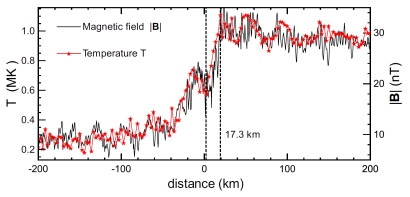Cluster measures the size of Earth's bow shock

Date: 15 November 2011
Satellite: Cluster
Depicts: The magnetic field strength and electron temperature in the plasma surrounding Earth's bow shock
Copyright: Courtesy of Steven Schwartz, Imperial College London
This graph shows measurements performed with one of the four spacecraft of ESA's Cluster mission during a favourable crossing of Earth's bow shock that took place on 9 January 2005.
The bow shock is a standing shock wave that forms when the solar wind encounters the magnetosphere of our planet. Shown in the graph are the intensity of the magnetic field (in black) and the electron temperature (in red) measured as this spacecraft was flying through the transition layer between the non-shocked and shocked regions of the plasma. The shock location is indicated at the centre, and distances are relative to its location.
As the four spacecraft make the transition into the shocked region of the plasma, they record how the electrons experience a dramatic and abrupt rise in temperature over scales of only about 17 kilometres. The rise in temperature follows closely the steep rise in the intensity of the magnetic field. Such a sharp transition is close to the limit set by wave dispersion and could hardly be any steeper, implying that the shock layer is as thin as it can be.
The thickness of the bow shock is a crucial parameter in investigating the physical processes taking place within that region. Thin astrophysical shocks such as this are candidate sites for early phases of particle acceleration. The finding thus sheds new light on the much debated issue of particle injection in the context of cosmic ray acceleration.
